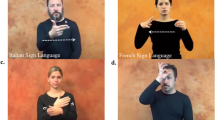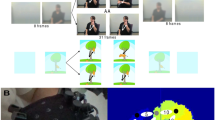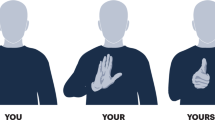Abstract
Many deaf people in the USA communicate in American sign language (ASL), which has an expressive capacity equivalent to that of a spoken language, although structurally independent of spoken languages1,2. It comprises hand and arm movements often combined with particular facial gestures; together these are sufficiently precise to transmit all the complexities and innuendoes of a language. Here we demonstrate that fluent ASL users can communicate easily when all they see of each other is an array of 27 light spots strategically placed on the hands and face. The results indicate the salient locations in normal sign perception, and suggest that it is feasible to transmit signs using the bandwidth of one telephone line rather than a much more expensive TV line.
This is a preview of subscription content, access via your institution
Access options
Subscribe to this journal
Receive 51 print issues and online access
$199.00 per year
only $3.90 per issue
Buy this article
- Purchase on Springer Link
- Instant access to full article PDF
Prices may be subject to local taxes which are calculated during checkout
Similar content being viewed by others
References
Bellugi, U. & Klima, E. S. in Origin and Evolution of Language and Speech (eds Harnad, S. R., Steklis, H. D. & Lancaster, J.) 515–538 (N. Y. Acad. Sci., 1976).
Grosjean, F. in Recent Perspectives in American Sign Language (eds Lane, H. & Grosjean, F.) (Lawrence Erlbaum, New Jersey, in the press).
Siple, P. in Understanding Sign Language through Sign Language Research 3–23 (Academic, New York, 1978).
Stokoe, W. C., Casterline, D. & Croneburg, C. A Dictionary of American Sign Language on Linguistic Principles (Gallaudet College Press, Washington DC, 1965).
Battison, R. Lexical Borrowing in American Sign Language (Linstok, Maryland, 1978).
Bellugi, U. & Fischer, S. Cognition 1, 173–200 (1972).
Johansson, G. Percept. Psychophys. 14, 201–211 (1973).
Johansson, G., von Hofsten, C. Jr & Jansson, G. A. Rev. Psychol. 27–63 (1980).
Poizner, H., Bellugi, U. & Lutes-Driscoll, V. Journal of Experimental Psychology: Human Perception and Performance (in the press).
Author information
Authors and Affiliations
Rights and permissions
About this article
Cite this article
Tartter, V., Knowlton, K. Perception of sign language from an array of 27 moving spots. Nature 289, 676–678 (1981). https://doi.org/10.1038/289676a0
Received:
Accepted:
Issue Date:
DOI: https://doi.org/10.1038/289676a0
This article is cited by
-
Viewing angle matters in British Sign Language processing
Scientific Reports (2024)
-
Understanding the recognition of facial identity and facial expression
Nature Reviews Neuroscience (2005)
Comments
By submitting a comment you agree to abide by our Terms and Community Guidelines. If you find something abusive or that does not comply with our terms or guidelines please flag it as inappropriate.



